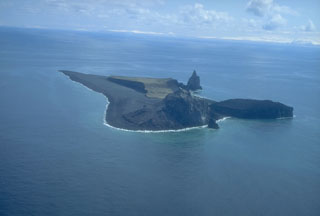Report on Bogoslof (United States) — 16 August-22 August 2017
Smithsonian Institution / US Geological Survey
Weekly Volcanic Activity Report, 16 August-22 August 2017
Managing Editor: Sally Sennert.
Please cite this report as:
Global Volcanism Program, 2017. Report on Bogoslof (United States) (Sennert, S, ed.). Weekly Volcanic Activity Report, 16 August-22 August 2017. Smithsonian Institution and US Geological Survey.
Bogoslof
United States
53.93°N, 168.03°W; summit elev. 150 m
All times are local (unless otherwise noted)
AVO reported that photographs of Bogoslof taken during an overflight on 15 August showed that the vent area (which had dried out during the 7 August eruption) had refilled with water. Seismicity decreased on 16 August and remained low at least through 18 August. Weakly elevated surface temperatures consistent with a warm lake were identified in satellite data during 19-20 August. Satellite data acquired on 21 August showed an approximately 125-m-diameter lava dome within the intra-island lake, just W of the 1992 lava dome. A cold volcanic plume, likely from the lava dome, drifted about 55 km S of the island. Some minor explosions were detected in infrasound data at about 0410 on 22 August. The lava dome had grown to 160 m in diameter. The Aviation Color Code remained at Orange and the Volcano Alert Level remained at Watch.
Geological Summary. Bogoslof is the emergent summit of a submarine volcano that lies 40 km N of the main Aleutian arc. It rises 1,500 m above the Bering Sea floor. Repeated construction and destruction of lava domes at different locations during historical time has greatly modified the appearance of this "Jack-in-the-Box" volcano and has introduced a confusing nomenclature applied during frequent visits by exploring expeditions. The present triangular-shaped, 0.75 x 2 km island consists of remnants of lava domes emplaced from 1796 to 1992. Castle Rock (Old Bogoslof) is a steep-sided pinnacle that is a remnant of a spine from the 1796 eruption. The small Fire Island (New Bogoslof), about 600 m NW of Bogoslof Island, is a remnant of a lava dome formed in 1883.
Source: US Geological Survey Alaska Volcano Observatory (AVO)

